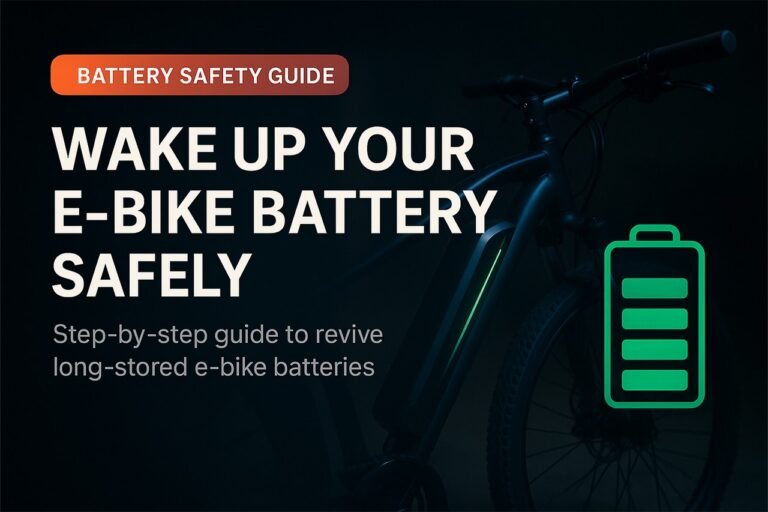
Charging an electric bike might seem like a no-brainer, but you’d be surprised how many people get it wrong and end up shortening their battery life or worse, damaging the entire system. Whether you’re a brand-new e-bike owner or someone who’s had one gathering dust in the garage, this guide will walk you through every crucial step. By the end, you’ll know how to charge your electric bike safely, correctly, and in a way that keeps your battery in peak condition for the long haul.
These are the basic steps for charging your electric bike correctly:
1. Turn off the e-bike before plugging it in.
2. Use the charger that came with your bike.
3. Plug the charger into the wall first, then the bike.
4. Charge the battery until it reaches 100% — but don’t overcharge.
5. Unplug the charger from the wall before disconnecting from the bike.
In the rest of this article, I’ll break down each of those steps with added detail. We’ll also explore battery types, best charging practices, temperature concerns, real-world scenarios, charging myths, and how to get the most mileage and longevity out of your e-bike battery.
What You’re Going To Need
- Your electric bike
- The manufacturer-supplied charger
- Access to a grounded wall outlet (110V-240V depending on your region)
- A dry, shaded, and well-ventilated location
- Optional: Battery manual or e-bike instruction manual
- Optional: Surge protector or smart plug for additional safety
- A soft cloth to clean the charging port
STEP 1: Turn Off the E-Bike Before Plugging It In
This step might seem minor, but it’s critical. Always turn off your electric bike before charging. Leaving it on can confuse the bike’s battery management system (BMS), possibly triggering errors or even cutting off the charging process entirely.
Tip: Some models won’t allow charging unless they are fully powered off. It’s a built-in safety feature.
Turning the bike off ensures that all systems are in a dormant state, preventing potential surges and reducing stress on the battery.
STEP 2: Use the Charger That Came With Your Bike
Different batteries have different voltage, amp ratings, and charging logic. Always use the original charger that came with your e-bike or a certified replacement from the manufacturer. Third-party options are tempting, especially cheaper ones online, but they pose real risks including battery degradation and even fire hazards.
Tip: If your charger gets hot during use, unplug it immediately and let it cool down. Overheating could signal internal failure.
When in doubt, contact your e-bike brand or dealer for a proper replacement that won’t void your warranty.
STEP 3: Plug the Charger into the Wall First, Then the Bike
Here’s where many people unknowingly go wrong. Always plug the charger into the wall first. Why? Because plugging it into the battery first can cause a mini spark, which over time degrades the charging port and creates carbon buildup.
Why it matters: That tiny spark is essentially electrical arcing — and it doesn’t just shorten component lifespan, it can be a fire hazard under the right (or wrong) conditions.
After plugging into the wall, wait a few seconds to let the charger stabilize, then connect it to the battery port. That’s the safest order.
STEP 4: Charge the Battery Until It Reaches 100% — But Don’t Overcharge
Most lithium-ion batteries used in e-bikes are designed to handle full charges. However, leaving them at 100% for too long can degrade battery chemistry over time. Ideally, unplug the charger once full or use a smart charger that automatically stops charging when it hits capacity.
Tip: Some riders aim for 80%-90% charges for daily commuting. It’s a smart way to stretch your battery’s lifespan.
A full charge once every few weeks helps balance the cells, but for daily use, keeping it within a partial charge range can significantly improve longevity.
STEP 5: Unplug the Charger from the Wall First
When the battery is full, reverse the connection order. Always unplug from the wall before disconnecting from the bike. This minimizes the chance of residual current sparking at the battery port.
Extra Care Tip: Wipe the charging port gently before closing it. Dirt or moisture can affect your next charge or even cause corrosion.
Additionally, don’t coil your charging cable tightly. Wrap it loosely to avoid damaging internal wires.
BONUS: Understanding Your Battery Type
Most modern e-bikes run on Lithium-Ion (Li-ion) batteries, which offer a sweet spot between weight, efficiency, and lifespan. Some older models might use Nickel Metal Hydride (NiMH) or Lead-Acid, but these are increasingly rare.
Here’s what you need to know:
- Avoid full discharges: Don’t drain to 0%. Charge when you hit 20%-30%.
- Let the battery cool before charging: Charging a hot battery reduces chemical efficiency and lifespan.
- Clean it occasionally: Dust and moisture around terminals can lead to inefficient charging or slow corrosion.
- Balance charging: Some e-bikes benefit from a full 100% charge every 20-30 cycles to equalize cell voltages.
Pro Insight: If your battery starts performing erratically, check for a firmware update. Some modern e-bikes have smart BMS units that receive updates.
How Often Should You Charge Your E-Bike?
There’s no universal schedule. It depends on battery size, motor power, terrain, and your riding habits. But here’s a rough guideline:
- Daily commuter? Charge every day or every other day.
- Weekend rider? Charge after every ride, or when it drops below 40%.
- Occasional rider? Charge once a month, but always check the charge level before heading out.
Charging habit hack: Don’t obsess over keeping it topped off. E-bike batteries don’t have “memory” like old batteries. Top it up when convenient.
Can You Charge an E-Bike at a Public Charging Station?
You can, but compatibility varies widely. Most public charging stations are designed for electric cars or large scooters. Unless there’s a standard wall outlet available, your best bet is to carry your own charger.
Travel tip: A compact folding charger or charging adapter can save your day if you’re touring or commuting long-distance.
Some cities are starting to install e-bike specific charging docks. Check local maps or apps like PlugShare to find them.
Storing and Charging in Cold or Hot Weather
Temperature extremes are harsh on battery health. Charging outside the recommended temperature range can lead to reduced efficiency or even permanent damage.
- Cold (below 40°F / 5°C): Let the battery warm indoors before charging.
- Hot (above 95°F / 35°C): Avoid direct sunlight and give the battery time to cool after riding.
Safe zone: Charge your battery between 50°F and 77°F (10°C – 25°C) for optimal performance.
Storage tip: For long-term storage (like winter), charge the battery to 60% and keep it in a dry, climate-controlled space.
Common Charging Mistakes to Avoid
Here are some of the most frequent charging blunders riders make:
- Leaving it plugged in for days (overcharging shortens battery life)
- Using non-original or uncertified chargers
- Charging immediately after a ride (let it cool)
- Ignoring dirty or wet charging ports
- Charging in high humidity or wet environments
- Using power strips with poor surge protection
Maintenance reminder: Clean your charging contacts monthly with a dry cotton swab.
FAQs About Charging E-Bikes
Q: Can I charge my e-bike overnight?
A: Yes, if your charger has an automatic shutoff. Still, unplug when you wake up if possible.
Q: How long does a full charge take?
A: Typically 3 to 6 hours. Fast chargers may cut that in half but can wear batteries faster.
Q: Should I remove the battery for charging?
A: You can if it’s removable. Just keep it in a safe, ventilated area.
Q: What happens if I use the wrong charger?
A: You risk fire, battery swelling, or permanent damage. Always use a charger approved for your model.
Q: Is it okay to ride immediately after charging?
A: Yes, just make sure the battery isn’t unusually warm.
Q: Can I use solar chargers for e-bikes?
A: Yes, with an inverter and the right setup. It’s slow, but eco-friendly.
Recommended E-Bike Chargers
Need a backup or faster charger? These are trusted options:
- Grin Technologies Cycle Satiator – Premium, customizable, and compatible with most battery types
- Lectric eBikes 48V Charger – OEM style, solid choice for common setups
- Juiced Bikes Advanced Charger – Adjustable charging rates, battery-safe options
Tip: Never go by plug shape alone. Voltage, amperage, and BMS compatibility must match.
Final Thoughts
Charging your electric bike correctly is one of the easiest ways to protect your investment and ride worry-free. With just a little awareness, you can avoid common pitfalls, maximize your battery’s health, and even squeeze out a bit more range every ride.
We covered every aspect from plug order and battery types to weather effects, charging myths, and FAQs. The golden rule is: treat your e-bike battery like a delicate piece of tech, not just a gas tank with wires.
So keep your charger handy, plug in smartly, and enjoy the smooth, silent thrill of electric biking. And remember: a well-charged e-bike is a happy e-bike.
Ride safe. Charge smarter. Explore more.








